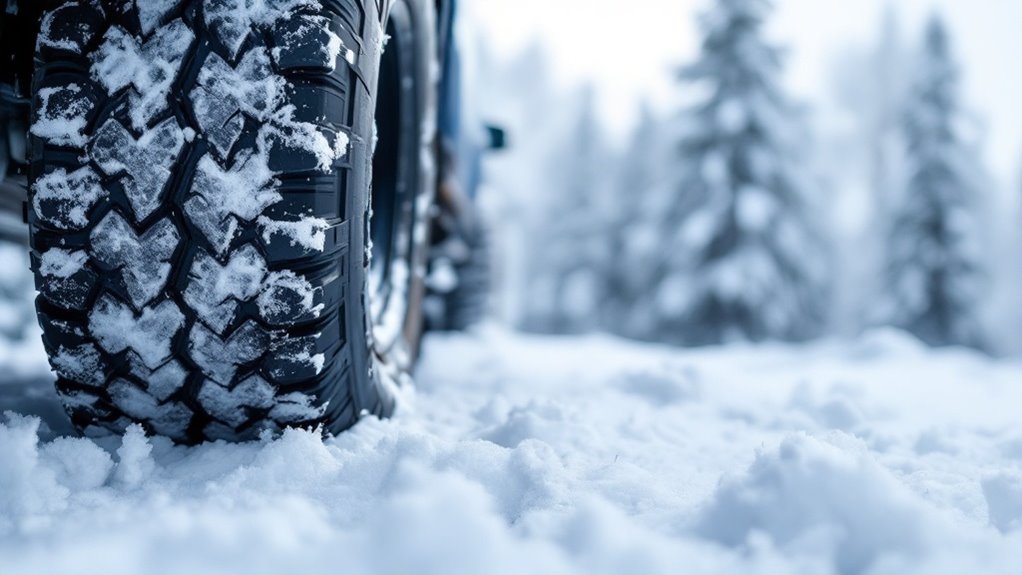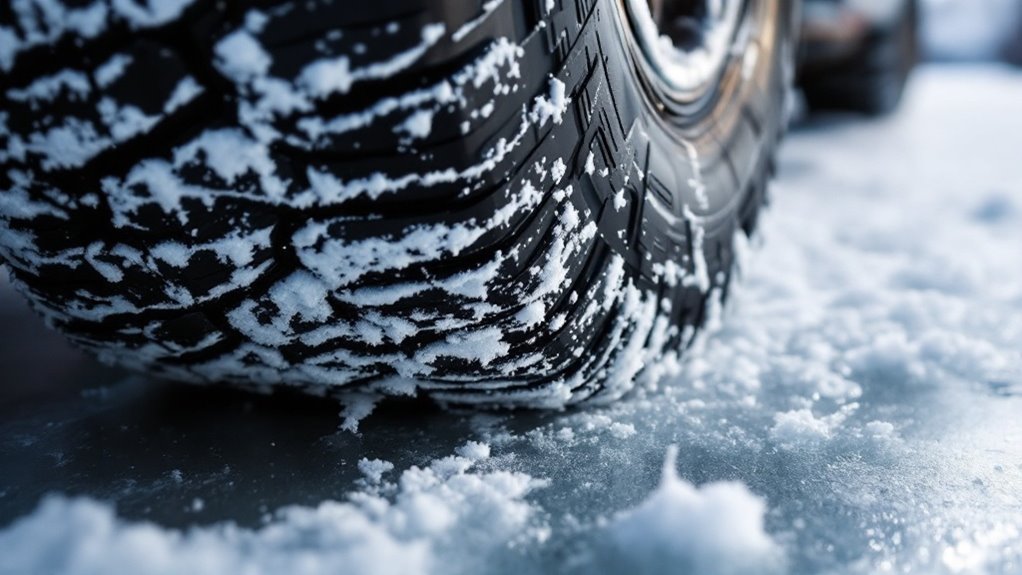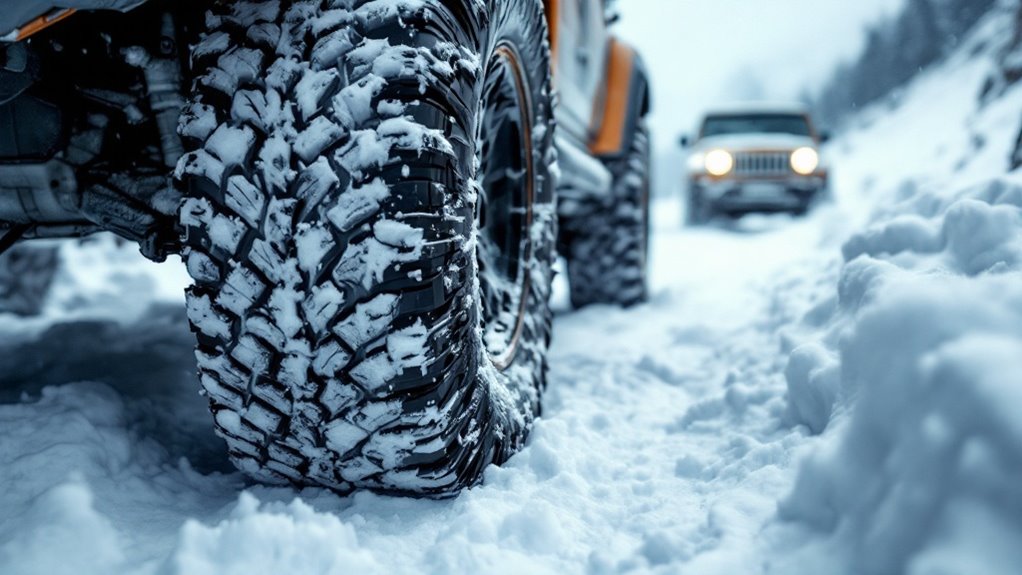Are Mud Tires Good For Snow
This post contains affiliate links. As an Amazon Associate, we earn from qualifying purchases.
Are mud tires good for snow? Sorry, they don’t work well in snowy weather. Their big, chunky treads slip on packed snow or ice. Mud tires have hard rubber that gets stiff below 45°F. This cuts down their grip a lot. Winter tires use soft rubber for better hold. Mud tires miss the tiny cuts and V-shapes snow tires have. Traction suffers because of this. Safety matters most in winter driving. Think about using winter tires or all-terrain ones instead. Stick around for more helpful tips.
Essential Facts in 30 Seconds
- Mud tires are not suitable for snow due to poor traction on packed snow and ice.
- Their large, blocky treads trap snow, decreasing grip in winter conditions.
- Mud tire rubber hardens in cold temperatures, reducing flexibility and increasing sliding risks.
- Snow tires, with softer compounds and sipes, are better suited for winter driving.
- Snow tires are the recommended option for safe winter driving over mud tires.
Understanding Mud Tires in Winter Conditions
Mud tires shine off-road, but they flop in winter, especially on snow. Their design fits rough trails, not cold, icy roads.
Big tread blocks grab mud well, yet slip on packed snow. Traction drops a lot on ice, raising safety risks. This is because wider tires can struggle in deep slush, which mud tires are not designed to handle effectively.
Below 45°F (7°C), the rubber gets stiff and loses grip. Flexible tires matter for safe winter drives, and mud tires fail here. Their limited usefulness in packed snow and ice makes them unreliable for severe conditions.
Let’s break it down quick.
- Snow Skills: They handle light snow okay, but ice? No chance.
- Cold Effect: Stiff rubber means less control in freezing temps.
Relying on mud tires in harsh winter spells trouble. Poor handling puts you at risk on snowy paths.
Switch to better options for safety and steady control.
Analyzing Tread Design for Snow Traction

Let’s talk about tread design for snow traction. Mud tires look tough and rugged. But they don’t work well in snowy weather. Their big, blocky treads grab mud nicely. Yet, snow sticks inside them easily. This makes them slip on icy roads. Winter tires are designed specifically to provide better traction in these conditions.
Snow tires are a better choice for winter. They’ve special V-shaped grooves. These grooves push snow out fast. Snow tires also have tiny cuts called sipes. Sipes help grip slippery snow tightly. Mud tires miss these important features. As a bonus, Discount Tire offers an extensive tire selection to suit various vehicle needs and weather conditions.
Check out the main differences in tread designs:
- Mud Tires: Big blocks, few sipes, snow gets stuck.
- Snow Tires: Many sipes, deep grooves, clears snow well.
Snow tires keep you safe on winter roads. Their design touches icy surfaces better. Trust me, mud tires can’t compete here. Pick snow tires for reliable winter driving.
Impact of Rubber Compounds on Cold Weather Grip

Let’s talk about rubber compounds and their role in winter tire grip. Cold weather changes how tires work on icy roads. Regular mud tires get hard and stiff below freezing. This makes them slip more on snow and ice. In contrast, winter tires are designed to provide enhanced traction and safety.
Winter tires use special mixes with natural rubber and silica. These stay soft even under 7°C. Soft rubber sticks better to rough, icy surfaces. The flexibility of these compounds ensures better traction in harsh winter conditions.
Check out these key points on tire performance in cold:
- Mud tires: Hard compounds lose grip fast.
- Winter tires: Soft mixes keep you safe.
Soft rubber helps tires grab snow with tiny bends. This gives you better control on tricky roads. Data shows winter tires cut sliding risks by 30%. Picking tires with flexible rubber matters a lot. It keeps your drive safe in harsh winter cold. Trust me, this choice can save you!
Certification Standards for Winter Performance

Picking the right winter tires can be tricky. Let’s make it simple! Safety on snowy and icy roads matters a lot.
Know the difference between M+S and 3PMSF certifications. M+S means Mud and Snow. It focuses only on tread design. No ice grip tests happen for M+S.
On the other hand, 3PMSF stands for Three Peak Mountain Snowflake. This one is stricter and safer. Tests for 3PMSF are tough. They check snow traction and ice grip. Tires must show 18% better grip than standard ones. Tests also happen below 7°C or 45°F.
Third-party checks ensure the results are real. Trust these standards for winter safety! Additionally, it’s important to note that snow tires are specifically designed to perform optimally in cold temperatures.
Compare them quick. M+S skips ice testing. Some places allow it till 2024. But 3PMSF is a must in the EU since 2018. Mountain areas often demand 3PMSF tires.
Always peek at local rules. Stick to stricter laws for better protection. Drive safe this winter!
Comparing Mud Tires to Other Options in Snowy Environments

Let’s dive into how mud tires compare to other tires in snowy areas.
Mud tires have bold treads and big gaps. They rock in off-road mud! But, they slip on packed snow or ice. Why? They lack tiny cuts for grip and get hard in cold.
Now, check out all-terrain tires. They handle light snow pretty well. Their design balances many conditions.
Then, snow tires shine the brightest in winter. They’ve special cuts for deep snow. Truly the best! Their unique tread patterns ensure optimal performance in icy conditions.
Here’s a quick look at their performance:
- Mud Tires: Bad in snow, great for mud.
- All-Terrain Tires: Okay in snow, very flexible.
- Snow Tires: Amazing in snow, perfect for winter.
Pick all-terrain or snow tires for snowy roads. They keep you safe and steady in tough weather. Trust these over mud tires for winter drives!
Frequently Asked Questions
Can Mud Tires Be Used Year-Round?
Got questions about using mud tires all year? Think carefully! Mud tires rock off-road. But they flop in winter weather. Snow and cold mess them up. Traction drops a lot on icy roads. Studies show 30% less grip in snow. Stick to warm, muddy trails for best results. Switch tires for safety in chilly months. Keep your ride secure and steady!
Are Mud Tires Safe for Highway Driving?
Mud tires on highways? Think again. They lack proper grip for fast roads. Their tread suits dirt, not smooth pavement. You hear more noise while driving. Safety drops with these tires. Pick all-season tires instead. They handle highways much better. Data shows mud tires wear out faster on roads. Stick to safer options for daily drives.
How Do Mud Tires Affect Fuel Efficiency?
Got mud tires on your ride? They’re awesome for off-road fun! But, they cost you more at the pump. Mud tires create high rolling resistance. That means your engine works harder. Data shows they can cut fuel efficiency by 10-20%. So, you burn more gas. Still, their grip rocks on rough trails. You pick adventure over saving money! Isn’t that a cool trade-off?
Do Mud Tires Wear Faster in Winter?
Got a question about mud tires in winter? They do wear out quicker. Cold weather makes the rubber hard. Hard rubber loses grip fast. Aggressive treads fight on icy roads. This battle speeds up tread damage. Studies show 20% faster wear in winter. Keep an eye on your tires. Replace them if treads look worn. Stay safe on those slippery paths!
Are Mud Tires Noisy on Paved Roads?
Ever hear a loud buzz on a calm road? Mud tires cause that noise on paved streets. Their rough tread design grips dirt well. Yet, it makes a strong hum on hard roads. Studies show mud tires are 10-20% louder than regular tires. That sound can annoy drivers a lot. Want quiet rides? Think twice before picking mud tires for daily use. They shine off-road, not on highways. Stick to smoother tires for city driving. Your ears will thank you!
Conclusion
Are mud tires good for snow? Let’s find out together! Mud tires have strong treads. They give some grip on snowy roads. But, they’re not the best choice. Why? They miss special rubber for cold weather. They don’t have the snowflake symbol for winter safety.
Dedicated snow tires work much better. They shine in icy, freezing conditions. Check this simple table for clarity:
| Tire Type | Snow Traction | Cold Grip |
|---|---|---|
| Mud Tires | Okay | Bad |
| Winter Tires | Great | Great |
Stick with winter tires for safety. They keep you steady on snow. Don’t risk it with mud tires. Make the smart pick today!
